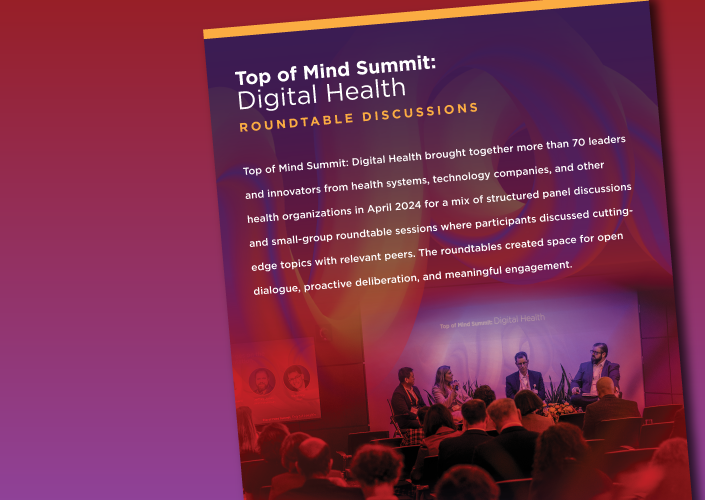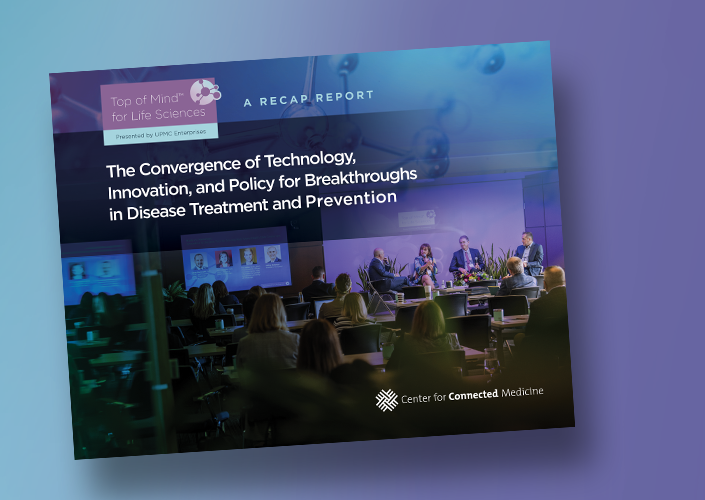ONC chief Micky Tripathi discusses federal efforts to improve interoperability with UPMC’s Rob Bart
The COVID-19 pandemic exposed gaps in the nation’s public health data interoperability that the government is working to fill, “regardless of whether we think this (pandemic) is going to happen every five years,” said Micky Tripathi, PhD, the National Coordinator for Health Information Technology at the U.S. Department of Health and Human Services.
“We’re very much focused on the standards and infrastructure capabilities to make sure we have the ecosystem set up right to be able to do what the providers, public health registers, payers, technology vendors, and patients, want to be able to do,” Dr. Tripathi said during the keynote presentation for Top of Mind Online, a virtual learning series from the Center for Connected Medicine (CCM).
Dr. Tripathi spoke with Rob Bart, MD, Chief Medical Information Officer, UPMC, for the keynote, titled “Health IT’s Next Horizon: Enabling Access Through Data-Sharing,” which was the first session in the three-part Top of Mind Online program. Register now to view an on-demand replay of the keynote and to watch sessions 2 and 3.
Addressing ‘bare spots’ in national data interoperability
Among the steps ONC is taking to address “bare spots” in the ability for health care system stakeholders to share information is collaborating with the Centers for Disease Control and Prevention (CDC) to enable a public health data model using national data standards, Dr. Tripathi said.
Dr. Bart responded that he already has seen some incremental improvement in standardization of public health data reporting UPMC is required to perform. With more than 40 hospitals across three states, the requests from local and state health departments varied significantly early in the pandemic. But over the past two years, Dr. Bart said, his team has experienced increased standardization in the requests for data that they receive.
Dr. Bart continued, “It helps me feel the world will get simpler and that we’ll leverage the technology to help us address this while still meeting the constitutional guides on state control.”
‘On the cusp’ of better interoperability
Dr. Bart and Dr. Tripathi also addressed TEFCA, or the Trusted Exchange Framework and Common Agreement
The goal of TEFCA is to establish a base for national health data interoperability by creating an infrastructure model and governing approach for users to securely share basic clinical information.
Dr. Bart asked Dr. Tripathi how health systems should help ONC advance its goals.
Tripathi commented that he wants providers to have confidence that systems are going to work and that the information they need will be there. Just like most people don’t know how mobile phones seamlessly connect to the internet no matter their individual carriers, “it just works.”
“Providers have been exposed too much to having to figure out the plumbing and not being able to spend enough time figuring out medicine and how to deliver quality care,” he said.
Dr. Bart responded that he believes the framework for data interoperability is something that UPMC and other health systems are embracing. “I really do think that we’re on the cusp of doing something that will change the direction of where health care has been in the interoperability space,” he said.
“I really do think that we’re on the cusp of doing something that will change the direction of where health care has been in the interoperability space" - Dr. Rob Bart
How can health systems earn top marks?
In the coming year, Dr. Bart asked, what does an A+ grade look like for health systems when it comes to complying with rules and regulations around interoperability and information-blocking?
Health systems should take full advantage of Fast Healthcare Interoperability Resource (FHIR) APIs to share data. Health care providers are in control of who can access their APIs, and health systems should “push hard to get that FHIR API in place and think expansively…for what that technology can do,” Dr. Tripathi said.
There is also an Oct. 6, 2022, deadline for health systems to comply with Information Blocking rules, requiring that all electronically available health information be made available. The requirement includes unstructured notes and other electronic information that isn’t always easily shared. Dr. Tripathi recommended health systems work with their EHR vendor to make sure these data can be surfaced.
“We recognize that’s not an easy thing,” Dr. Tripathi said. “But the A+ student is already looking at that and saying what are all these other systems and what are the channels we’re going to use to make these available.”
More great speakers at Top of Mind Online
The full program focuses on patient access, a top priority for digital health investment and the challenge health system leaders believe can be best addressed with technology, according to CCM research.
Session 2 of the Top of Mind Online program, “Health Care Infrastructure: Fixing the Foundation,” features Chris Carmody, Chief Technology Officer at UPMC, Emily Webber, MD, Chief Medical Information Officer at Indiana University Health, and Ashis Barad, MD, System Medical Director, Virtual Specialty Care Services at Baylor Scott & White Health, discussing the role of fortified infrastructure in maximizing technology for improved access to care.
Session 3, “Access Innovation: Meeting Patients Where They Are,” features Joon Lee, MD, Senior Vice President of UPMC and President of UPMC Physician Services, with Amir Dan Rubin, Chair, CEO, and President of One Medical, and Rebecca Kaul, PhD, Chief Innovation Officer of MD Anderson Cancer Center, exploring how digital health technologies are boosting consumer experience, convenience, loyalty, and health outcomes at health systems.
More from the CCM’s Top of Mind program
Learn more about the full Top of Mind Online virtual learning series



